We found a series of vintage Spanish cards with pictures of silent film stars - in blue, brown, purple, pink, and green. Not exactly a common style, now nor then. And all the pictures are oval-formed, to top it off. These blank-backed cards were published in Barcelona by Francisco Mario Bistagne, editor of 'La Novela Semanal Cinematográfica'. This magazine was very popular in Spain from November 1922, when the first number appeared, until August 1932, when it stopped being published. Interestingly, the cards show that Italian stars must have been still popular in Spain at the time, and there are also many cards of forgotten stars whose postcards are now hard to find. Ivo and I selected 50 cards which we will publish in two posts. The second post will follow tomorrow.

Spanish postcard by La Novela Semanal Cinematográfica, Número especial (special number).
Majestic diva of the Italian silent cinema Francesca Bertini (1892-1985) was one of the first European film stars. During the first quarter of the twentieth century, she often played the 'femme fatale', with men devouring eyes, glamorous attire, clenched fists, and in opulent settings.
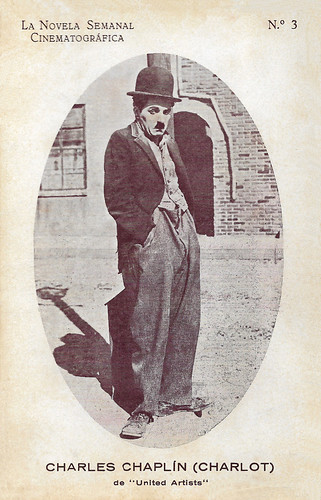
Spanish postcard by La Novela Semanal Cinematográfica, no. 3. Photo: United Artists (but the film was produced by First National). Charles Chaplin in A Dog's Life (Charles Chaplin, 1918). Charlot was the Spanish nickname for Chaplin.

Spanish postcard by La Novela Semanal Cinematográfica, no. 13.
Marie Prevost (1898-1937) was a Canadian-born, American silent screen actress. She was excellent in such comedies as Ernst Lubitsch's The Marriage Circle (1924). The end of her life was filled with tragedies.
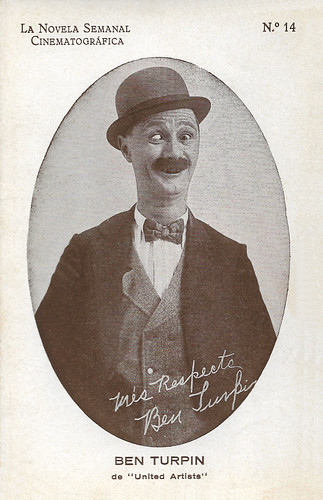
Spanish card by La Novela Semanal Cinematográfica, no. 14. Photo: United Artists.
Cross-eyed silent comedian Ben Turpin (1869-1940) was not born that way. Supposedly his right eye slipped out of alignment while playing the role of the similarly afflicted Happy Hooligan in vaudeville and it never adjusted. Ironically, it was this disability that would enhance his comic value and make him a top name in the silent film era. Turpin's true forte was impersonating the most dashingly romantic and sophisticated stars of the day and turning them into clumsy oafs. He also invented a Hollywood tradition by being the first actor to receive a pie in his face.

Spanish card by La Novela Semanal Cinematográfica, no. 15.
Fascinating and enigmatic Pina Menichelli (1890-1984) was the most bizarre Italian diva of the silent era. With her contorted postures and disdainful expression, she impersonated the striking femme fatale.
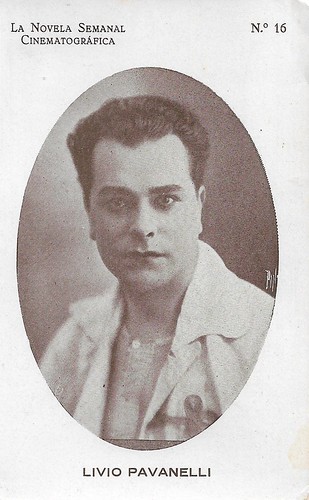
Spanish postcard by La Novela Semanal Cinematográfica, no. 16. Photo Pinto, Rome.
Livio Pavanelli (1881-1958) was an Italian actor of the Italian and in particular German silent cinema. He also worked in Italian sound cinema as an actor and as a production manager. He directed four Italian films, both in the silent and the sound era.

Spanish postcard by La Novela Semanal Cinematográfica, no. 19.
Gladys Walton (1903-1993) was an American actress, who peaked in the American silent film of the 1920s. She was a flapper in such films such as The Girl Who Ran Wild (1922), and The Wise Kid (1922).

Spanish postcard by La Novela Semanal Cinematográfica, no. 20.
Aimé Simon-Girard (1889-1950) was a French film actor and operetta singer. He mostly played in French costume films of the 1920s and 1930s.
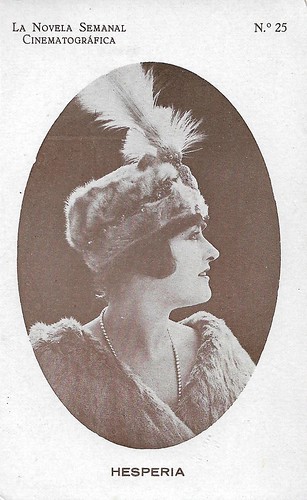
Spanish postcard by La Novela Semanal Cinematográfica, no. 25.
Hesperia (1885-1959), was one of the Italian divas of the silent screen. She often worked with director Baldassarre Negroni, who later became her husband.

Spanish postcard by La Novela Semanal Cinematográfica, no. 34.
George Walsh (1889-1981) was an American film actor, who despite a successful career in silent cinema is best remembered for the part that was taken off from him: the title role in Ben-Hur (1925).

Spanish card by La Novela Semanal Cinemátografica, no. 52.
Alberto Capozzi (1886-1945) was an Italian film and stage actor who had an enormous career in Italian cinema in the 1910s and early 1920s. Afterward, he pursued a career abroad in Austria and as a sound dubber in France. He returned to film acting in Italian cinema in the early 1940s.

Spanish postcard by La Novela Semanal Cinematografica, no. 72.
Thomas Meighan (1879-1936) was an American stage and screen actor. He starred in seven silent films by William C. de Mille and five others by his brother, Cecil B. DeMille.

Spanish card by La Novela Semanal Cinematográfica, no. 73.
Mary Philbin (1902-1993) was an American film actress of the silent film era, who is best known for playing the roles of Christine Daaé in The Phantom of the Opera (Rupert Julian, 1925) opposite Lon Chaney, and as Dea in The Man Who Laughs (Paul Leni, 1928), opposite Conrad Veidt.

Spanish postcard by La Novela Semanal Cinematografica, no. 75.
Alla Nazimova (1879–1945) was a grand, highly flamboyant star of the American silent cinema. The Russian-born film and theatre actress, screenwriter, and film producer was widely known as just Nazimova. On Broadway, she was noted for her work in the classic plays of Ibsen, Chekhov, and Turgenev. Her efforts at silent film production were less successful, but a few sound-film performances survive as a record of her art.
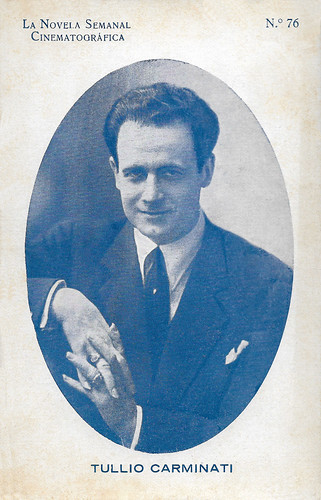
Spanish card by La Novela Semanal Cinematográfica, no. 76.
Tullio Carminati (1895-1971) was an Italian stage and film actor with a longstanding career from the 1910s to the 1960s. He played in Italian, German, American, British, and French films and on Italian, American, and British stages.

Spanish card by La Novela Semanal Cinematográfica, no. 77.
Virginia Valli (1895–1968) was an American stage and film actress whose motion picture career started in the silent film era and lasted until the beginning of the sound film era of the 1930s.

Spanish card by La Novela Semanal Cinematográfica, no. 78.
Was Austrian-born Erich von Stroheim (1885-1957) a Hollywood movie star or a European film star? (Who cares!) As the sadistic, monocled Prussian officer in both American and French films, he became ‘The Man You Love to Hate’. But maybe he is best known as one of the greatest and influential directors of the silent era, known for his extravaganza and the uncompromising accuracy of detail in his monumental films.

Spanish card by La Novela Semanal Cinematográfica, no. 81.
Jacqueline Logan (1901-1983) was an American actress of the silent screen. Her most famous part is that of Mary Magdalene in the biblical epic The King of Kings (1927) by Cecil B. DeMille.
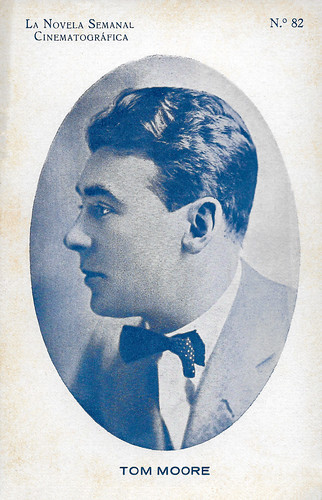
Spanish card by La Novela Semanal Cinemátografica, no. 82.
Tom Moore (1883-1955) was an Irish-American actor and director. From 1908 to 1954, he appeared in at least 186 films. Frequently cast as the romantic lead, he starred in silent films as well as in some of the first sound films.
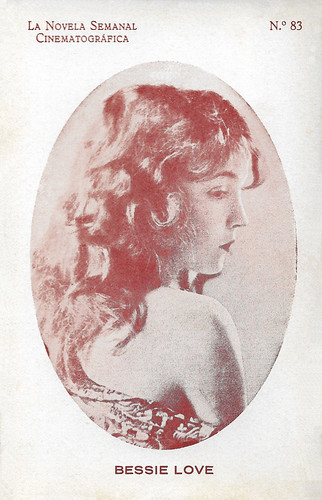
Spanish postcard by La Novela Semanal Cinematografica, no. 83.
American actress Bessie Love (1898-1986) was introduced to the cinema by D.W. Griffith. He also gave the actress her screen name. She played innocent young girls and wholesome leading ladies in silent films and early talkies. Her acting career spanned eight decades, and her role in The Broadway Melody (1929) earned her a nomination for the Oscar for Best Actress.
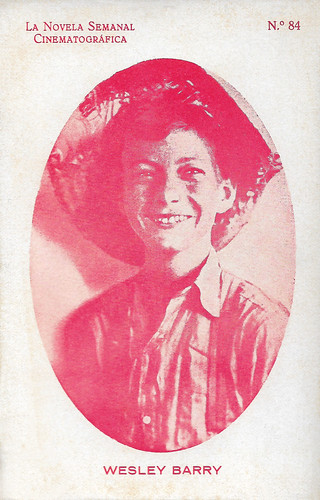
Spanish card by La Novela Semanal Cinematográfica, no. 84.
Wesley Barry (1907-1994) was an adorable child actor in silent films who was known for his face full of freckles. He later became a producer and director of both film and television. As a director, he was sometimes billed as Wesley E. Barry.
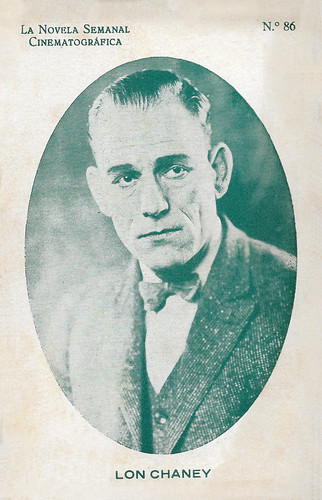
Spanish postcard by La Novela Semanal Cinematografica, no. 86.
American stage and film actor, director, and screenwriter Lon Chaney (1883-1930) is regarded as one of the most versatile and powerful actors of early cinema. Between 1912 and 1930 he played more the 150 widely diverse roles. He is renowned for his characterizations of tortured, often grotesque and afflicted characters, and his groundbreaking artistry with makeup. ‘The Man of a Thousand Faces’ starred in such silent horror films as The Hunchback of Notre Dame (1923) and The Phantom of the Opera (1925).

Spanish postcard by La Novela Semanal Cinematografica, no. 87.
Corinne Griffith (1894–1979) was an American film actress, producer, and author. Dubbed 'The Orchid Lady of the Screen', she was one of the most popular film actresses of the 1920s and widely considered the most beautiful actress of the silent screen. While she started out at Vitagraph in 1916, she became a very popular actress at First National Pictures. Griffith was nominated for the Academy Award for Best Actress for her performance in Frank Lloyd's The Divine Lady, a 1929 American Vitaphone sound film with a synchronised musical score, sound effects, and some synchronised singing, but no spoken dialogue. Griffith played the female lead of Lady Hamilton, opposite Victor Varconi as Horatio Nelson. When sound film set in, Griffith stopped acting and became a successful writer and businesswoman.
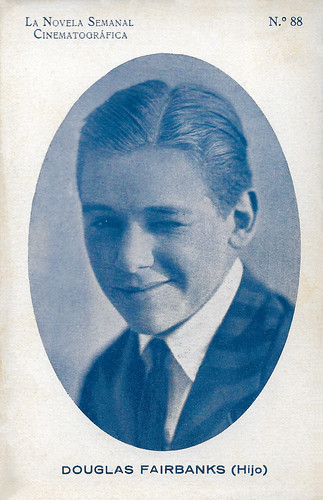
Spanish card by La Novela Semanal Cinematográfica, no. 88.
Handsome and distinguished, Douglas Fairbanks Jr. (1909-2000) was much more than the son of his superstar father. He was a bright, multi-talent, who excelled in sports and sculpting, was involved in the business, and was knighted for his war efforts as a lieutenant. And he acted in approximately 100 films or TV shows.

Spanish card by La Novela Semanal Cinematográfica, no. 89.
Anita Stewart (1895-1961) was an American actress who achieved success during the silent period. From 1911 on, she worked with director Ralph Ince for Vitagraph, later she had her own film company at Metro. The advent of the sound film ended her career.
To be continued tomorrow.

Spanish postcard by La Novela Semanal Cinematográfica, Número especial (special number).
Majestic diva of the Italian silent cinema Francesca Bertini (1892-1985) was one of the first European film stars. During the first quarter of the twentieth century, she often played the 'femme fatale', with men devouring eyes, glamorous attire, clenched fists, and in opulent settings.

Spanish postcard by La Novela Semanal Cinematográfica, no. 3. Photo: United Artists (but the film was produced by First National). Charles Chaplin in A Dog's Life (Charles Chaplin, 1918). Charlot was the Spanish nickname for Chaplin.

Spanish postcard by La Novela Semanal Cinematográfica, no. 13.
Marie Prevost (1898-1937) was a Canadian-born, American silent screen actress. She was excellent in such comedies as Ernst Lubitsch's The Marriage Circle (1924). The end of her life was filled with tragedies.

Spanish card by La Novela Semanal Cinematográfica, no. 14. Photo: United Artists.
Cross-eyed silent comedian Ben Turpin (1869-1940) was not born that way. Supposedly his right eye slipped out of alignment while playing the role of the similarly afflicted Happy Hooligan in vaudeville and it never adjusted. Ironically, it was this disability that would enhance his comic value and make him a top name in the silent film era. Turpin's true forte was impersonating the most dashingly romantic and sophisticated stars of the day and turning them into clumsy oafs. He also invented a Hollywood tradition by being the first actor to receive a pie in his face.

Spanish card by La Novela Semanal Cinematográfica, no. 15.
Fascinating and enigmatic Pina Menichelli (1890-1984) was the most bizarre Italian diva of the silent era. With her contorted postures and disdainful expression, she impersonated the striking femme fatale.

Spanish postcard by La Novela Semanal Cinematográfica, no. 16. Photo Pinto, Rome.
Livio Pavanelli (1881-1958) was an Italian actor of the Italian and in particular German silent cinema. He also worked in Italian sound cinema as an actor and as a production manager. He directed four Italian films, both in the silent and the sound era.

Spanish postcard by La Novela Semanal Cinematográfica, no. 19.
Gladys Walton (1903-1993) was an American actress, who peaked in the American silent film of the 1920s. She was a flapper in such films such as The Girl Who Ran Wild (1922), and The Wise Kid (1922).

Spanish postcard by La Novela Semanal Cinematográfica, no. 20.
Aimé Simon-Girard (1889-1950) was a French film actor and operetta singer. He mostly played in French costume films of the 1920s and 1930s.

Spanish postcard by La Novela Semanal Cinematográfica, no. 25.
Hesperia (1885-1959), was one of the Italian divas of the silent screen. She often worked with director Baldassarre Negroni, who later became her husband.

Spanish postcard by La Novela Semanal Cinematográfica, no. 34.
George Walsh (1889-1981) was an American film actor, who despite a successful career in silent cinema is best remembered for the part that was taken off from him: the title role in Ben-Hur (1925).

Spanish card by La Novela Semanal Cinemátografica, no. 52.
Alberto Capozzi (1886-1945) was an Italian film and stage actor who had an enormous career in Italian cinema in the 1910s and early 1920s. Afterward, he pursued a career abroad in Austria and as a sound dubber in France. He returned to film acting in Italian cinema in the early 1940s.

Spanish postcard by La Novela Semanal Cinematografica, no. 72.
Thomas Meighan (1879-1936) was an American stage and screen actor. He starred in seven silent films by William C. de Mille and five others by his brother, Cecil B. DeMille.

Spanish card by La Novela Semanal Cinematográfica, no. 73.
Mary Philbin (1902-1993) was an American film actress of the silent film era, who is best known for playing the roles of Christine Daaé in The Phantom of the Opera (Rupert Julian, 1925) opposite Lon Chaney, and as Dea in The Man Who Laughs (Paul Leni, 1928), opposite Conrad Veidt.

Spanish postcard by La Novela Semanal Cinematografica, no. 75.
Alla Nazimova (1879–1945) was a grand, highly flamboyant star of the American silent cinema. The Russian-born film and theatre actress, screenwriter, and film producer was widely known as just Nazimova. On Broadway, she was noted for her work in the classic plays of Ibsen, Chekhov, and Turgenev. Her efforts at silent film production were less successful, but a few sound-film performances survive as a record of her art.

Spanish card by La Novela Semanal Cinematográfica, no. 76.
Tullio Carminati (1895-1971) was an Italian stage and film actor with a longstanding career from the 1910s to the 1960s. He played in Italian, German, American, British, and French films and on Italian, American, and British stages.

Spanish card by La Novela Semanal Cinematográfica, no. 77.
Virginia Valli (1895–1968) was an American stage and film actress whose motion picture career started in the silent film era and lasted until the beginning of the sound film era of the 1930s.

Spanish card by La Novela Semanal Cinematográfica, no. 78.
Was Austrian-born Erich von Stroheim (1885-1957) a Hollywood movie star or a European film star? (Who cares!) As the sadistic, monocled Prussian officer in both American and French films, he became ‘The Man You Love to Hate’. But maybe he is best known as one of the greatest and influential directors of the silent era, known for his extravaganza and the uncompromising accuracy of detail in his monumental films.

Spanish card by La Novela Semanal Cinematográfica, no. 81.
Jacqueline Logan (1901-1983) was an American actress of the silent screen. Her most famous part is that of Mary Magdalene in the biblical epic The King of Kings (1927) by Cecil B. DeMille.

Spanish card by La Novela Semanal Cinemátografica, no. 82.
Tom Moore (1883-1955) was an Irish-American actor and director. From 1908 to 1954, he appeared in at least 186 films. Frequently cast as the romantic lead, he starred in silent films as well as in some of the first sound films.

Spanish postcard by La Novela Semanal Cinematografica, no. 83.
American actress Bessie Love (1898-1986) was introduced to the cinema by D.W. Griffith. He also gave the actress her screen name. She played innocent young girls and wholesome leading ladies in silent films and early talkies. Her acting career spanned eight decades, and her role in The Broadway Melody (1929) earned her a nomination for the Oscar for Best Actress.

Spanish card by La Novela Semanal Cinematográfica, no. 84.
Wesley Barry (1907-1994) was an adorable child actor in silent films who was known for his face full of freckles. He later became a producer and director of both film and television. As a director, he was sometimes billed as Wesley E. Barry.

Spanish postcard by La Novela Semanal Cinematografica, no. 86.
American stage and film actor, director, and screenwriter Lon Chaney (1883-1930) is regarded as one of the most versatile and powerful actors of early cinema. Between 1912 and 1930 he played more the 150 widely diverse roles. He is renowned for his characterizations of tortured, often grotesque and afflicted characters, and his groundbreaking artistry with makeup. ‘The Man of a Thousand Faces’ starred in such silent horror films as The Hunchback of Notre Dame (1923) and The Phantom of the Opera (1925).

Spanish postcard by La Novela Semanal Cinematografica, no. 87.
Corinne Griffith (1894–1979) was an American film actress, producer, and author. Dubbed 'The Orchid Lady of the Screen', she was one of the most popular film actresses of the 1920s and widely considered the most beautiful actress of the silent screen. While she started out at Vitagraph in 1916, she became a very popular actress at First National Pictures. Griffith was nominated for the Academy Award for Best Actress for her performance in Frank Lloyd's The Divine Lady, a 1929 American Vitaphone sound film with a synchronised musical score, sound effects, and some synchronised singing, but no spoken dialogue. Griffith played the female lead of Lady Hamilton, opposite Victor Varconi as Horatio Nelson. When sound film set in, Griffith stopped acting and became a successful writer and businesswoman.

Spanish card by La Novela Semanal Cinematográfica, no. 88.
Handsome and distinguished, Douglas Fairbanks Jr. (1909-2000) was much more than the son of his superstar father. He was a bright, multi-talent, who excelled in sports and sculpting, was involved in the business, and was knighted for his war efforts as a lieutenant. And he acted in approximately 100 films or TV shows.

Spanish card by La Novela Semanal Cinematográfica, no. 89.
Anita Stewart (1895-1961) was an American actress who achieved success during the silent period. From 1911 on, she worked with director Ralph Ince for Vitagraph, later she had her own film company at Metro. The advent of the sound film ended her career.
To be continued tomorrow.
No comments:
Post a Comment